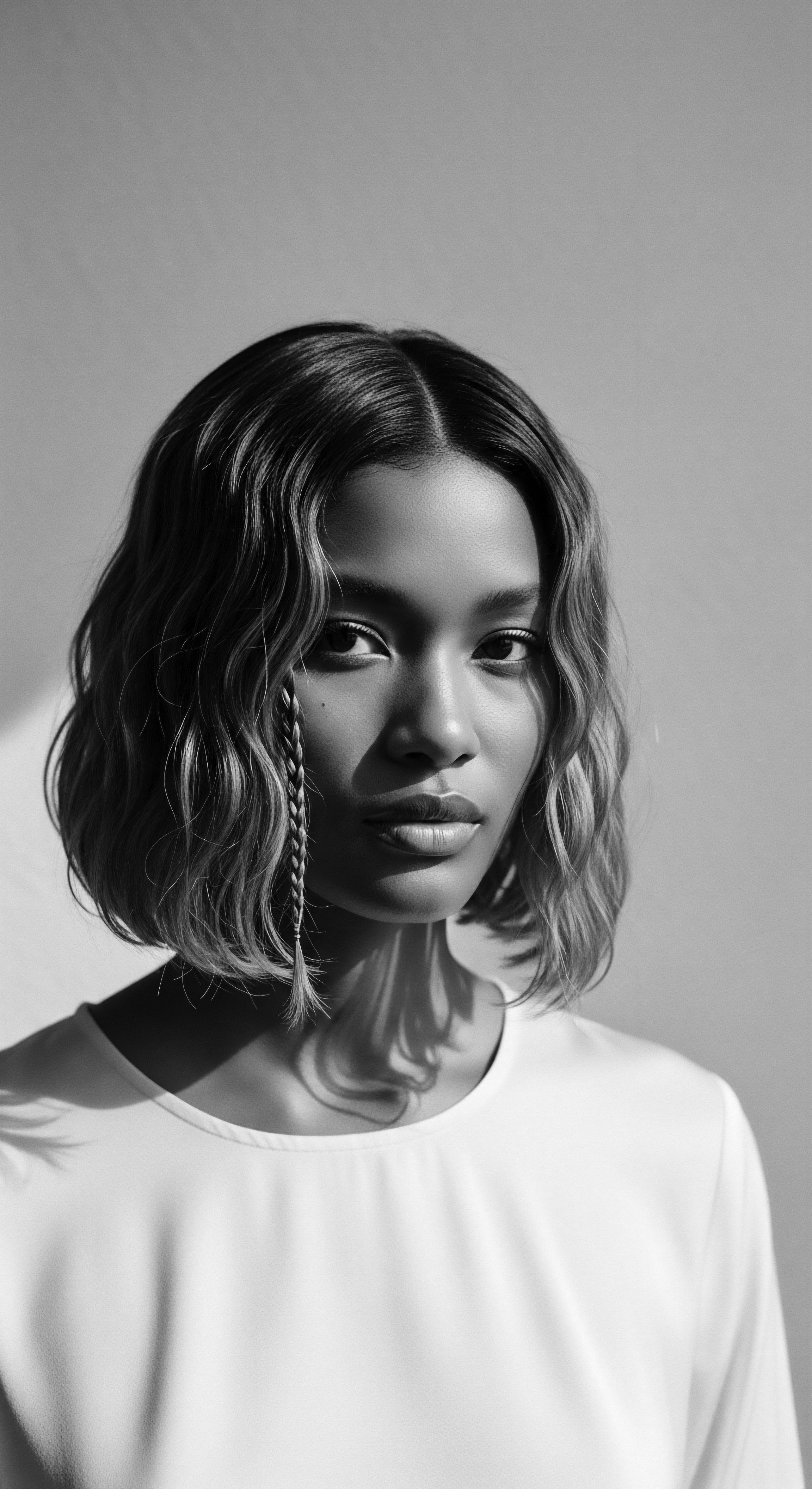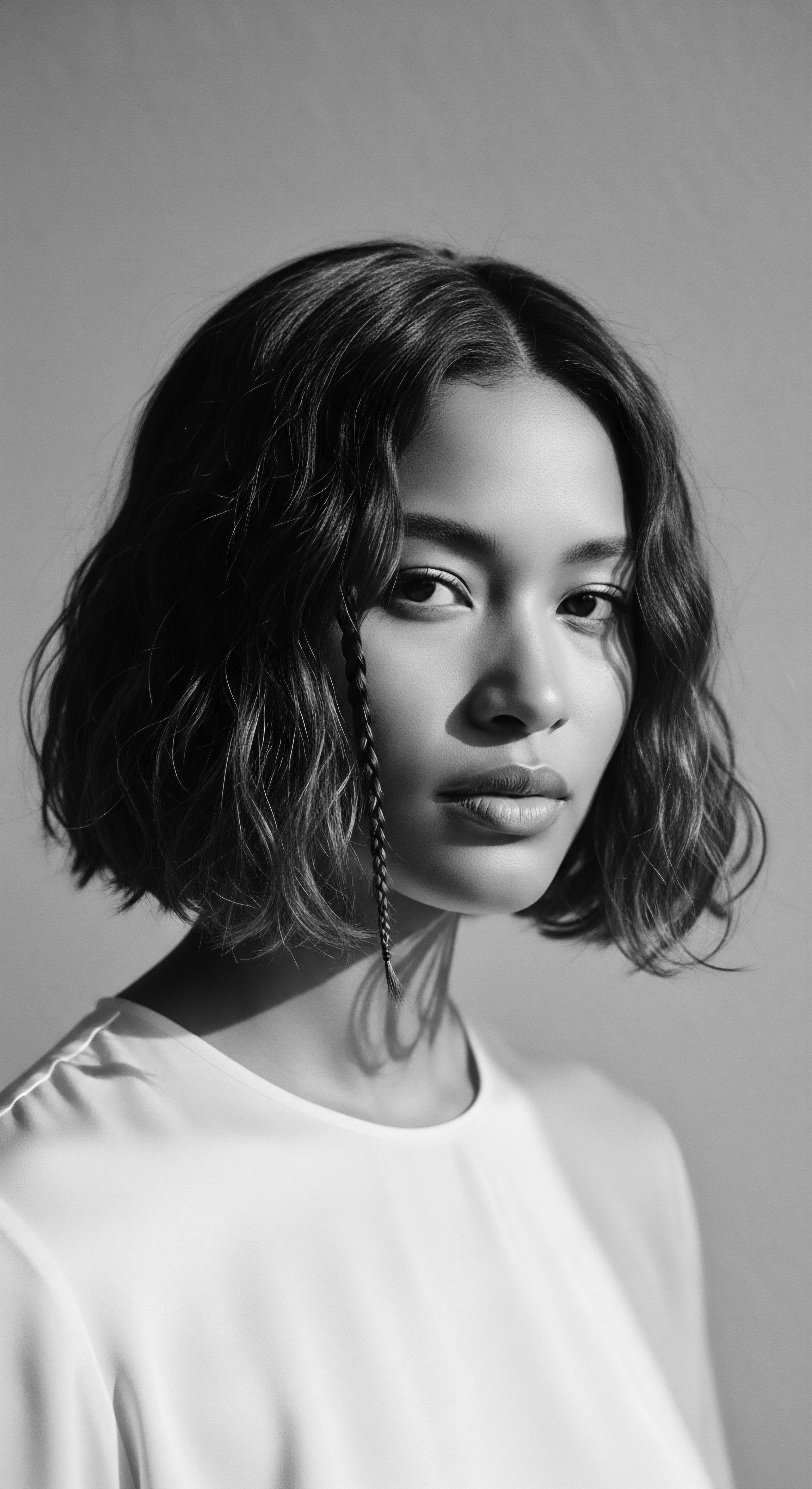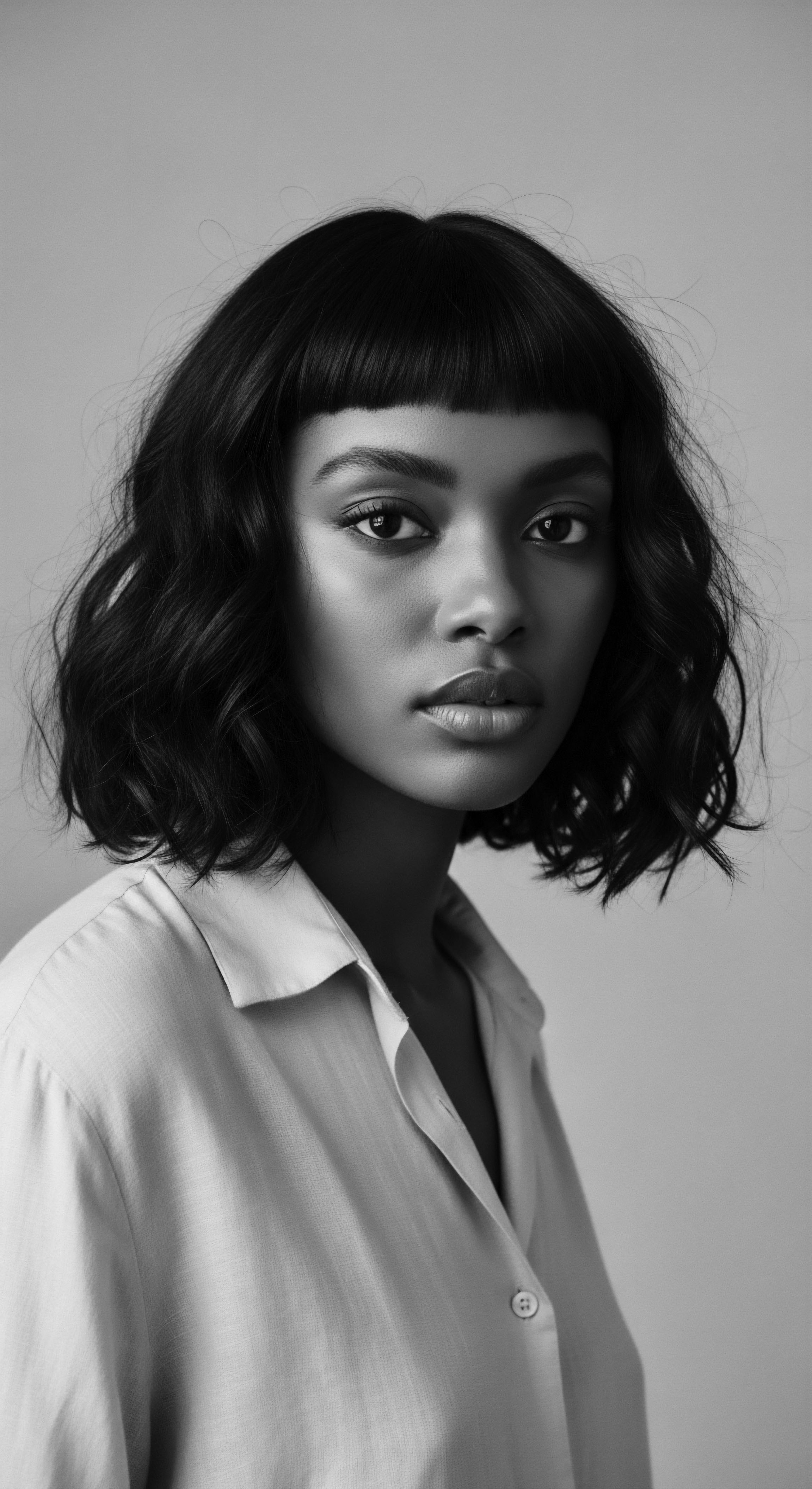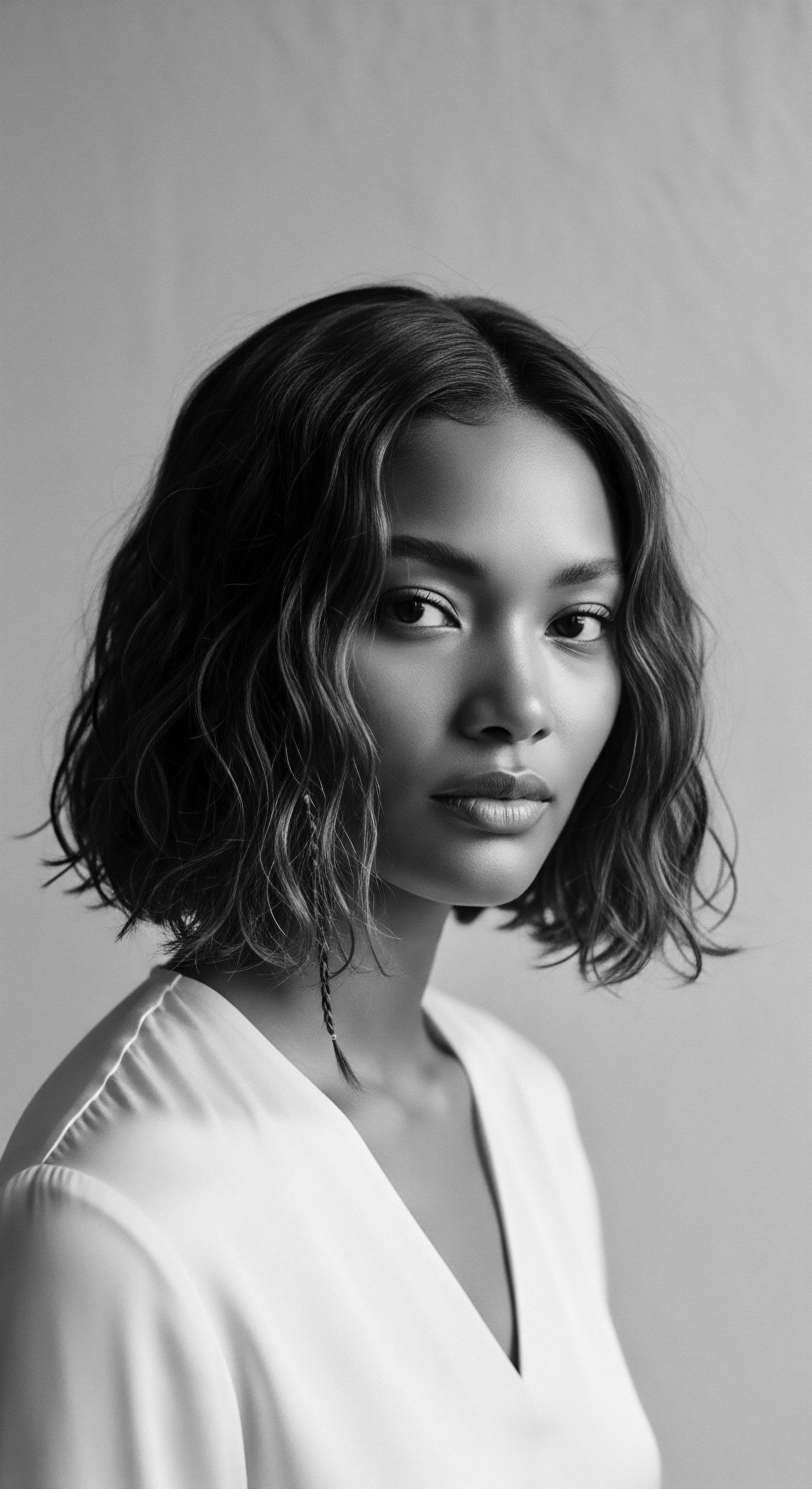
Fundamentals
The concept of ‘Textured Hair Traditions’ represents a profound and enduring understanding of hair, particularly the coils, curls, and waves inherent to Black and mixed-race ancestries, viewed through the lens of ancestral practices and cultural heritage. It is not merely a description of hair types or styling methods; rather, it signifies the collective wisdom, passed across generations, concerning the care, adornment, and symbolic significance of hair. This understanding is deeply rooted in the historical contexts where textured hair flourished as a natural expression of identity, community, and spiritual connection. The designation of ‘Textured Hair Traditions’ offers an explanation of how these practices, developed over millennia, have shaped the relationship individuals and communities hold with their hair, positioning it as a living extension of their legacy.

Echoes from the Source ❉ Ancient Beginnings
From the earliest recorded histories, textured hair has been a canvas for profound cultural expression and a repository of meaning across African civilizations. The historical significance of hair in African societies is well-documented, extending back to 3500 BCE, with archaeological evidence showing intricate braiding patterns on figurines from that era (Afrocenchix, 2024). These ancient practices were far more than simple grooming; they were integral to daily life and communal identity. Hair conveyed a person’s age, marital status, social rank, religious beliefs, and tribal affiliation (Omotos, 2018, as cited in The Gale Review, 2021).
The deliberate shaping and adornment of hair served as a visual language, communicating complex social codes without uttering a single word. This deep connection to hair as a marker of identity and belonging was foundational to the Textured Hair Traditions, setting a precedent for how hair would be perceived and honored through subsequent eras.
Textured Hair Traditions define the ancestral practices and cultural meanings embedded within the care and styling of coiled, curly, and wavy hair.

The Sacred Strand ❉ Early Meanings
Across various African groups, hair held a sacred dimension, often believed to be a conduit for spiritual energy or a connection to the divine. The Yoruba people of Nigeria, for example, regarded hair as sacred, viewing it as a medium that links individuals to their ancestors and deities (Afriklens, 2024). This spiritual reverence meant that hair care rituals were not merely hygienic tasks but sacred ceremonies, often performed by elders or skilled practitioners.
The deliberate attention given to hair, from cleansing with natural ingredients to intricate styling, was an act of reverence for one’s physical self and one’s spiritual lineage. The early interpretation of hair as a spiritual anchor underscores the profound substance of Textured Hair Traditions, elevating daily practices to acts of deep cultural and spiritual import.
- Adornment ❉ Ancient African societies utilized a wide array of natural materials for hair adornment, including cowrie shells, beads, clay, and precious metals, each carrying specific symbolic weight (Afriklens, 2024).
- Ceremony ❉ Hair styling often accompanied rites of passage, such as coming-of-age ceremonies or marriage rituals, marking significant life transitions (Afriklens, 2024).
- Protection ❉ Traditional styles frequently served practical purposes, protecting hair from environmental elements and maintaining its health in diverse climates.

First Practices ❉ Cultivating Connection
The initial practices within Textured Hair Traditions revolved around natural, readily available resources and communal effort. Ethnobotanical studies reveal the historical reliance on local plant resources for hair care across African communities (Sharaibi et al. 2024). Ingredients such as shea butter, palm oil, and various indigenous herbs were staples, prized for their nourishing and protective properties (Sharaibi et al.
2024). The application of these natural elements was often a shared activity, fostering bonds between family members and within communities. Children learned styling techniques from older siblings and adults, ensuring the continuity of these practices (Afrocenchix, 2024). This communal aspect of hair care, where knowledge and techniques were transmitted through direct experience and observation, forms a central designation of Textured Hair Traditions, highlighting its deeply social and intergenerational character.

Intermediate
The intermediate understanding of ‘Textured Hair Traditions’ moves beyond foundational origins, exploring how these practices have persevered, adapted, and deepened through historical shifts, particularly within the Black and mixed-race diaspora. This perspective highlights the significance of hair care as a dynamic cultural phenomenon, continually shaped by both inherited wisdom and new realities. It offers a clarification of how ancestral methods, initially rooted in specific African contexts, transformed into resilient expressions of identity and resistance across diverse geographical landscapes. The concept speaks to the continuity of traditional hair care rituals and styling practices, demonstrating their enduring power as tools for self-expression and community solidarity.

Diaspora’s Enduring Legacy ❉ Adaptation and Resilience
The transatlantic slave trade presented an unprecedented challenge to the continuity of Textured Hair Traditions. Stripped of their material possessions and often forced to shave their heads upon capture, enslaved Africans faced a deliberate assault on their cultural identity (Sieber & Herreman, 2000, as cited in ResearchGate, 2023). Despite these brutal attempts at dehumanization, the deeply ingrained practices and meanings associated with textured hair persisted. Enslaved people continued to braid their hair, passing down techniques in secret, often incorporating new cultural influences (Haku Holistics, 2023).
This period saw the profound transformation of hair styling into a covert form of communication and resistance. For instance, cornrows were ingeniously used to hide maps and other directional instructions for escape routes, allowing individuals to navigate towards freedom (Haku Holistics, 2023). This specific historical example powerfully illuminates the Textured Hair Traditions’s connection to textured hair heritage and Black hair experiences, showcasing how ancestral practices became tools of survival and liberation (Afriklens, 2024). The ingenuity and resilience displayed during this period represent a crucial interpretation of Textured Hair Traditions, underscoring its role as a living archive of endurance.
The historical use of cornrows as clandestine maps during the transatlantic slave trade exemplifies the profound role of Textured Hair Traditions in Black resistance and cultural survival.

Rituals of Connection ❉ Sustaining Community
The preservation of Textured Hair Traditions in the diaspora fostered strong communal bonds. Hair care sessions often served as intimate gatherings, moments for storytelling, sharing wisdom, and reinforcing familial ties. These rituals were not merely about grooming; they were essential for psychological and social well-being. Mothers and grandmothers instilled in younger generations the understanding that “your hair is your crown and glory,” connecting hair care to self-esteem and pride in one’s heritage (Johnson & Bankhead, 2014).
This collective experience of hair care sustained cultural memory and provided a sense of belonging in environments that often sought to diminish Black identity. The enduring sense of intention behind these shared rituals provides a deeper sense of the Textured Hair Traditions, emphasizing its role in maintaining social cohesion and cultural continuity across time and space.
The continued practice of hair care rituals within Black and mixed-race communities highlights several key aspects:
- Intergenerational Transfer ❉ Knowledge of styling techniques, product preparation, and hair health is passed down through direct teaching and observation from elders to youth (Johnson & Bankhead, 2014).
- Community Spaces ❉ Hair salons and barber shops historically served as vital hubs for socialization, discussion, and the reinforcement of cultural values (The SAGE Encyclopedia of African Cultural Heritage in North America Hairstyles, Traditional African, 2015).
- Identity Affirmation ❉ Engaging in traditional hair practices affirms one’s connection to a rich cultural lineage, countering external pressures to conform to Eurocentric beauty standards (Afriklens, 2024).

Tools of Ancestry ❉ Evolving Implements
The tools and techniques associated with Textured Hair Traditions also reflect a continuous evolution, adapting to available resources while maintaining ancestral principles. From early combs crafted from wood or bone to the ingenuity of using simple household items for styling during slavery, the implements of hair care have always been extensions of communal knowledge. The modern resurgence of natural hair movements has seen a renewed appreciation for tools that respect the unique properties of textured hair, such as wide-tooth combs and natural bristle brushes. This practical aspect of the Textured Hair Traditions provides a clear delineation of its adaptive nature, showing how fundamental methods of care persist through changing eras.
| Historical Period Ancient Africa (3500 BCE onwards) |
| Traditional Tools/Practices Bone/wood combs, natural fibers for extensions, plant-based oils (e.g. palm oil). |
| Modern Parallels/Adaptations Wide-tooth combs, synthetic/human hair extensions, natural hair oils (e.g. shea butter, argan oil). |
| Historical Period Slavery Era (16th-19th Century) |
| Traditional Tools/Practices Fingers for braiding, simple household items, rudimentary tools for sectioning. |
| Modern Parallels/Adaptations Specialized sectioning clips, ergonomic combs, various braiding tools. |
| Historical Period 20th Century & Beyond |
| Traditional Tools/Practices Hot combs, chemical relaxers (often to conform). |
| Modern Parallels/Adaptations Heat protectants, chemical-free styling products, focus on protective styles (braids, twists, locs). |
| Historical Period The tools used in Textured Hair Traditions reflect both enduring ancestral wisdom and a continuous adaptation to contemporary needs, always rooted in hair health and cultural expression. |

Academic
The advanced understanding of ‘Textured Hair Traditions’ moves beyond a mere description of practices to a sophisticated analysis of its profound anthropological, historical, and biological underpinnings, particularly within the context of Black and mixed-race hair heritage. This is a comprehensive explication, viewing Textured Hair Traditions as a dynamic, complex system where cultural meaning, biological specificity, and social resilience converge. It is an interpretation that demands an expert-level grasp of how ancestral knowledge, often transmitted orally and through lived experience, aligns with contemporary scientific inquiry, providing a robust framework for appreciating this living heritage. The designation of Textured Hair Traditions, from an academic perspective, acknowledges its critical role in shaping identity, resisting oppression, and fostering community across the diaspora, serving as a testament to the enduring human spirit.

Interdisciplinary Perspectives ❉ Unpacking the Layers
The meaning of Textured Hair Traditions requires an interdisciplinary lens, drawing insights from anthropology, sociology, history, and the biological sciences. Anthropologically, hair in African societies functioned as a potent non-verbal communication system, signifying everything from age and marital status to social rank and spiritual beliefs (Sieber & Herreman, 2000). This semiotic role of hair meant that its styling was never arbitrary; rather, it was a deliberate act of self-definition within a communal context. Sociologically, the imposition of Eurocentric beauty standards during colonialism and slavery sought to dismantle these traditions, labeling natural textured hair as “unprofessional” or “bad hair” (Patton, 2006; Lewis et al.
2019, as cited in The Person Beneath the Hair, 2023). This historical pressure created a complex relationship with hair, where straightening became a means of survival or assimilation for some, while the embrace of natural styles became a powerful act of resistance and pride for others (Byrd & Tharps, 2014). The Black Power Movement of the 1960s and 70s, for instance, saw the Afro and braids become symbols of Black nationalism and a rejection of colonial beauty norms, asserting a return to African origins (Kelley, 2002; Mercer, 1994, as cited in Black Hair Is a Safe Sport Issue!, 2024). This historical evolution underscores the layered significance of Textured Hair Traditions as both a cultural artifact and a site of ongoing social discourse. The substance of Textured Hair Traditions is therefore not static; it is a continuously negotiated space of identity and belonging.
Textured Hair Traditions serve as a living archive of cultural resilience, where ancestral practices and styling choices continually articulate identity and resistance against historical pressures.

The Biology of Heritage ❉ Science and Ancestral Wisdom
From a scientific standpoint, textured hair possesses unique structural properties that necessitate specific care approaches, often validated by ancestral wisdom. The tightly coiled or curly nature of Afro-textured hair means that natural oils produced by the scalp do not easily travel down the hair shaft, leading to dryness and increased fragility (ResearchGate, 2017). This biological reality underpins the historical emphasis on moisturizing and protective styling within Textured Hair Traditions. For example, traditional practices often involved regular oiling and the use of butters like shea butter, which scientific research now affirms for their occlusive and emollient properties, helping to seal in moisture (Sharaibi et al.
2024). Furthermore, the practice of braiding and twisting, which are central to Textured Hair Traditions, minimizes manipulation and breakage, promoting length retention, a goal often observed in traditional African hair care methods (Reddit, 2021). An ethnobotanical survey in Northern Morocco, for instance, identified 42 plant species traditionally used for hair treatment and care, with a focus on strengthening, revitalizing, and addressing hair loss (Mouchane et al. 2023).
Such findings offer a scientific elucidation of the efficacy of ancient practices, connecting elemental biology to the rich tapestry of inherited care. The specification of these biological characteristics, and the ancestral responses to them, provides a deeper comprehension of Textured Hair Traditions.
The convergence of ancestral wisdom and modern scientific understanding is evident in several key areas:
- Moisture Retention ❉ Traditional application of natural oils and butters aligns with scientific understanding of their ability to reduce transepidermal water loss from the scalp and hair shaft (Sharaibi et al. 2024).
- Protective Styling ❉ Braids, twists, and locs, long-standing components of Textured Hair Traditions, are scientifically recognized as protective styles that reduce physical stress and breakage on delicate textured strands (ResearchGate, 2017).
- Ingredient Efficacy ❉ Ethnobotanical studies continue to document the use of various plants for hair health, with some showing potential for properties like anti-inflammatory or growth-promoting effects, inviting further scientific investigation (MDPI, 2024).

Future Trajectories ❉ Sustaining a Living Heritage
The ongoing evolution of Textured Hair Traditions demonstrates its adaptive capacity and enduring relevance in a globalized world. Contemporary movements advocating for natural hair reflect a collective reclamation of identity and a rejection of historical beauty biases (Smith Scholarworks, 2021). This re-affirmation is not merely a trend; it is a conscious decision by many to honor their ancestral legacy and promote self-acceptance. The meaning of Textured Hair Traditions today extends to advocating for legal protections against hair discrimination, such as the CROWN Act in the United States, which prohibits discrimination based on hair texture or protective styles (The Person Beneath the Hair, 2023).
This demonstrates how the personal experience of hair care has expanded into a broader social and political movement, striving for equity and cultural recognition. The ongoing efforts to integrate traditional knowledge with modern innovation, such as the development of culturally specific hair care products by Black-owned businesses, represents a powerful designation of the future of Textured Hair Traditions (Euromonitor.com, 2023). This continuing journey, deeply rooted in heritage, offers long-term insights into cultural success and resilience, underscoring that the Textured Hair Traditions are not a relic of the past, but a vibrant, evolving force shaping contemporary identity and well-being.

Reflection on the Heritage of Textured Hair Traditions
The journey through ‘Textured Hair Traditions’ unveils a story not merely of hair, but of enduring spirit, ancestral wisdom, and the profound connection between self and heritage. Each coil and curl holds a memory, a whisper from generations past, echoing resilience and beauty. This living library of hair practices, born from the earliest African civilizations and carried across continents, stands as a testament to the ingenuity and fortitude of Black and mixed-race communities.
It reminds us that care for textured hair is a deeply personal act, yet it is also a communal one, a continuation of sacred rituals that bind us to our lineage. The Soul of a Strand ethos finds its deepest expression here, recognizing that within every hair lies not only biological marvel but also a vibrant cultural narrative, a declaration of identity that has resisted erasure and continues to inspire profound self-acceptance and celebration.

References
- Afrocenchix. (2024, October 2). A Short Interesting History Of Hair Braiding. Afrocenchix.
- Afriklens. (2024, November 1). African Hairstyles ❉ Cultural Significance and Legacy. Afriklens.
- Haku Holistics. (2023, November 4). The Art of African Braiding ❉ A Historical Deep Dive. Haku Holistics.
- Johnson, T. & Bankhead, T. (2014). Hair It Is ❉ Examining the Experiences of Black Women with Natural Hair. Open Journal of Social Sciences, 2, 86-100.
- Mouchane, M. Taybi, H. Gouitaa, N. & Assem, N. (2023). Ethnobotanical Survey of Medicinal Plants used in the Treatment and Care of Hair in Karia ba Mohamed (Northern Morocco). Journal of Medicinal plants and By-Products, 13(1), 201-208.
- ResearchGate. (2017). Hair care practices in African American women. ResearchGate.
- ResearchGate. (2023). Hair in African Art and Culture. ResearchGate.
- SAGE Publications, Inc. (2015). The SAGE Encyclopedia of African Cultural Heritage in North America Hairstyles, Traditional African. SAGE Publications, Inc.
- Sharaibi, O. J. Oluwa, O. K. Omolokun, K. T. Ogbe, A. A. & Adebayo, O. A. (2024). Cosmetic Ethnobotany Used by Tribal Women in Epe Communities of Lagos State, Nigeria. J Complement Med Alt Healthcare, 12(4), 555845.
- Smith Scholarworks. (2021). The natural hair transformation ❉ a journey of resilience and resistance. Smith Scholarworks.
- The Gale Review. (2021, November 23). African Hairstyles – The “Dreaded” Colonial Legacy. The Gale Review.
- The Person Beneath the Hair. (2023, August 2). Hair Discrimination, Health, and Well-Being. PMC.
- Beds SU. (2022, October 7). Black History Month 2022 ❉ The History Behind Cornrows. Beds SU.
- Euromonitor.com. (2023, November 28). African Beauty Trends ❉ Opportunities for Beauty & Ingredient Players. Euromonitor.com.
- MDPI. (2024, February 2). Cosmetopoeia of African Plants in Hair Treatment and Care ❉ Topical Nutrition and the Antidiabetic Connection? MDPI.
- Reddit. (2021, August 26). No raw oils and butters vs. Traditional African hair care? ❉ r/Naturalhair. Reddit.
- Black Hair Is a Safe Sport Issue! ❉ Black Aesthetics, Access, Inclusion, and Resistance in. (2024, August 22).
